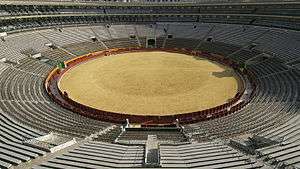Plaza de Toros de Valencia
Plaza de Toros de Valencia, officially Plaça de bous de València, is a bullring in València, Spain. It was built between 1850 and 1859[2] in the neoclassical style, inspired by civil Roman architecture such as the Colosseum[2] in Rome or the Arena of Nîmes (France). It was built by the Valencian architect Sebastián Monleón Estellés. Its structure is formed by a 48-sided polygon, with 384 external arches. It follows the so-called Neo-Mudéjar style.
El Coso Valenciano | |

| |
| Location | Xàtiva Street, Valencia, Spain |
|---|---|
| Coordinates | 39°28′00″N 0°22′35″W |
| Owner | Hospital General de Valencia |
| Capacity | 12,000[1] |
| Field size | 52 m inside diameter and 108 m outside |
| Construction | |
| Built | 1850–1859 |
| Opened | June 22, 1859 |
| Renovated | 1960 |
| Architect | Sebastián Monleón Estellés |
| Tenants | |
| Simon Casas Productions | |
| Website | |
| torosvalenciatour | |
Features

.jpg)
When constructed the bullfighting arena was outside the city walls near the Ruzafa Gate. The architect designed the 17.50 meter-high building with 48 sides. Originally the bullring had an inside diameter of 52 meters, which was later reduced. It is an early example of a building that used cast iron columns that provide remarkable transparency in the boxes. Plaza de Toros is one of the more beautiful bullrings in Spain, with an outside diameter of 108 meters and a capacity of 16,851 seated spectators (also reduced to 12,884 seats later on). These dimensions make it one of the largest bullrings in Spain. As reflected in the media at that time. It was inaugurated on June 20, 1859.[3]
Since 1625, the site is owned by the Hospital General and it is administered by the Provincial Council of Valencia and the Simon Casas Productions company. Over the years, it has been managed both by private companies and the Council of Valencia itself.
Location
The bullfighting arena is situated in the Centro district of the city, at 28 Calle de Xàtiva Valencia, 46004 Spain. It is located next to the North Station and also close to the Plaza del Ayuntamiento (Town Hall Square). Right in front of the bullring, there is a metro station called "Xàtiva" with the lines number 3, 5 and 9.
Capacity
The bullring holds around 10,500 people.
References
- http://www.torosvalenciatour.com/la-plaza/historia/
- El Mundo, n.º 626, domingo 26 de septiembre de 2011, Magacine pág. 32.
- Diario Mercantil de Valencia, 18 de junio 1859.